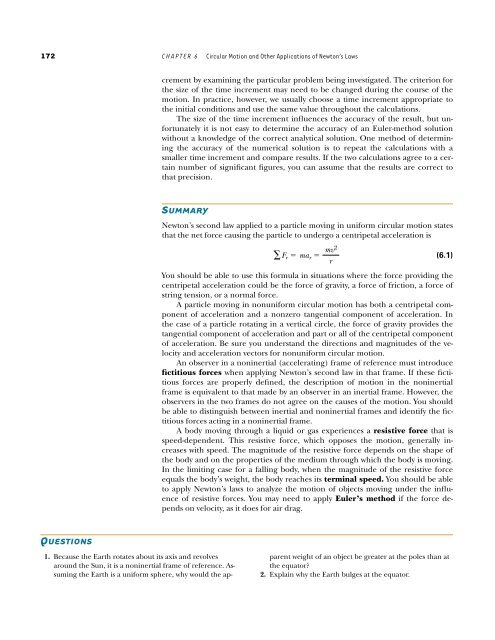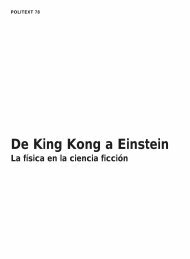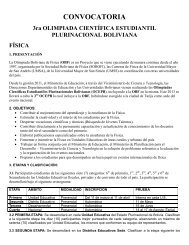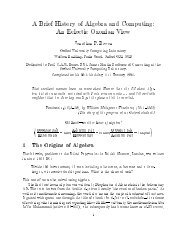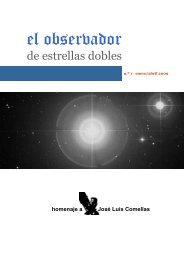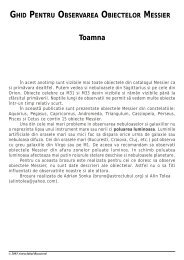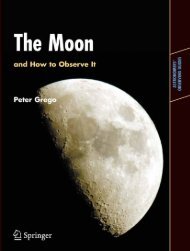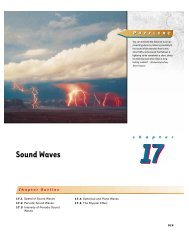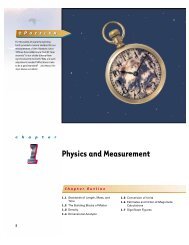Circular Motion and Other Applications of Newton's Laws
Circular Motion and Other Applications of Newton's Laws
Circular Motion and Other Applications of Newton's Laws
Create successful ePaper yourself
Turn your PDF publications into a flip-book with our unique Google optimized e-Paper software.
172 CHAPTER 6 <strong>Circular</strong> <strong>Motion</strong> <strong>and</strong> <strong>Other</strong> <strong>Applications</strong> <strong>of</strong> Newton’s <strong>Laws</strong><br />
QUESTIONS<br />
crement by examining the particular problem being investigated. The criterion for<br />
the size <strong>of</strong> the time increment may need to be changed during the course <strong>of</strong> the<br />
motion. In practice, however, we usually choose a time increment appropriate to<br />
the initial conditions <strong>and</strong> use the same value throughout the calculations.<br />
The size <strong>of</strong> the time increment influences the accuracy <strong>of</strong> the result, but unfortunately<br />
it is not easy to determine the accuracy <strong>of</strong> an Euler-method solution<br />
without a knowledge <strong>of</strong> the correct analytical solution. One method <strong>of</strong> determining<br />
the accuracy <strong>of</strong> the numerical solution is to repeat the calculations with a<br />
smaller time increment <strong>and</strong> compare results. If the two calculations agree to a certain<br />
number <strong>of</strong> significant figures, you can assume that the results are correct to<br />
that precision.<br />
SUMMARY<br />
1. Because the Earth rotates about its axis <strong>and</strong> revolves<br />
around the Sun, it is a noninertial frame <strong>of</strong> reference. Assuming<br />
the Earth is a uniform sphere, why would the ap-<br />
Newton’s second law applied to a particle moving in uniform circular motion states<br />
that the net force causing the particle to undergo a centripetal acceleration is<br />
�Fr � mar � (6.1)<br />
You should be able to use this formula in situations where the force providing the<br />
centripetal acceleration could be the force <strong>of</strong> gravity, a force <strong>of</strong> friction, a force <strong>of</strong><br />
string tension, or a normal force.<br />
A particle moving in nonuniform circular motion has both a centripetal component<br />
<strong>of</strong> acceleration <strong>and</strong> a nonzero tangential component <strong>of</strong> acceleration. In<br />
the case <strong>of</strong> a particle rotating in a vertical circle, the force <strong>of</strong> gravity provides the<br />
tangential component <strong>of</strong> acceleration <strong>and</strong> part or all <strong>of</strong> the centripetal component<br />
<strong>of</strong> acceleration. Be sure you underst<strong>and</strong> the directions <strong>and</strong> magnitudes <strong>of</strong> the velocity<br />
<strong>and</strong> acceleration vectors for nonuniform circular motion.<br />
An observer in a noninertial (accelerating) frame <strong>of</strong> reference must introduce<br />
fictitious forces when applying Newton’s second law in that frame. If these fictitious<br />
forces are properly defined, the description <strong>of</strong> motion in the noninertial<br />
frame is equivalent to that made by an observer in an inertial frame. However, the<br />
observers in the two frames do not agree on the causes <strong>of</strong> the motion. You should<br />
be able to distinguish between inertial <strong>and</strong> noninertial frames <strong>and</strong> identify the fictitious<br />
forces acting in a noninertial frame.<br />
A body moving through a liquid or gas experiences a resistive force that is<br />
speed-dependent. This resistive force, which opposes the motion, generally increases<br />
with speed. The magnitude <strong>of</strong> the resistive force depends on the shape <strong>of</strong><br />
the body <strong>and</strong> on the properties <strong>of</strong> the medium through which the body is moving.<br />
In the limiting case for a falling body, when the magnitude <strong>of</strong> the resistive force<br />
equals the body’s weight, the body reaches its terminal speed. You should be able<br />
to apply Newton’s laws to analyze the motion <strong>of</strong> objects moving under the influence<br />
<strong>of</strong> resistive forces. You may need to apply Euler’s method if the force depends<br />
on velocity, as it does for air drag.<br />
mv2<br />
r<br />
parent weight <strong>of</strong> an object be greater at the poles than at<br />
the equator?<br />
2. Explain why the Earth bulges at the equator.


